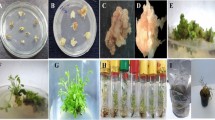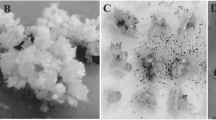Abstract
Aconitum carmichaelii Debx. is a medicinal plant that contains a variety of valuable medicinal substances, including flavonoids, alkaloids, and polysaccharides. Flavonoids are important substances because of their antioxidant, antiproliferative, and anticancer effects, but the flavonoid content in A. carmichaelii is low. Flavonoid 3′5′-hydroxylase (F3′5′H) is a key enzyme that catalyzes the final reactions in flavonoid biosynthesis in A. carmichaelii. Therefore, overexpressing the gene encoding of the F3′5′H enzyme to increase the flavonoid content in A. carmichaelii is a new direction in medicinal plant research strategies. In this work, the results of Agrobacterium tumefaciens–mediated genetic transformation of uidA and AcF3′5′H in A. carmichaelii plants, expression analysis of AcF3′5′H, and production of transgenic A. carmichaelii plants have been presented. Out of 180 transformed samples, 24 transgenic A. carmichaelii plants developed normally under greenhouse conditions. The results of PCR analysis of 15 transgenic A. carmichaelii plants showed that eight transgenic plants contained the AcF3′5′H transgene. Using electrophoresis SDS-PAGE, western blot, and ELISA techniques, we identified the expression of AcF3′5′H protein (rAcF3′5′H) in three transgenic plants. The rAcF3′5′H protein content of transgenic plants ranged from 0.2083 μg μL−1 (transgenic line T0-6) to 0.2507 μg μL−1 (T0-4). The highest concentrations of flavonoids, 773.50 ± 12.87, 661.73 ± 2.85, and 761.61 ± 9.10 μg g−1, were found in transgenic lines T0-4, T0-6, and T0-13, respectively. These values were higher than those of the non-transformed plants (wild-type). Our results demonstrate that compared with non-transgenic plants, overexpression of AcF3′5′H significantly increased the AcF3′5′H protein content in transgenic plants and the total flavonoid content in transgenic lines T0-4, T0-6, T0-13, from 39.13 to 63.63%. This is the first report of genetic transformation and an analysis of the expression enhancement of F3′5′H in the A. carmichaelii plant.






Similar content being viewed by others
References
Bradford MM (1976) Rapid and sensitive method for the quantitation of microgram quantities of protein utilizing the principle of protein-dye binding. Anal Biochem 72:248–254
Chandler SF, Senior M, Nakamura N, Tsuda S, Tanaka Y (2013) Expression of flavonoid 3′5′-hydroxylase and acetolactate synthase genes in transgenic carnation: assessing the safety of a nonfood plant. J Agric Food Chem 61:11711–11720. https://doi.org/10.1021/jf4004384
Chaves-Silva S, Dos Santos AL, Chalfun-Jr A, Zhao J, Peres LE, Benedito VA (2018) Understanding the genetic regulation of anthocyanin biosynthesis in plants-tools for breeding purple varieties of fruits and vegetables. Phytochemistry 153:11–27. https://doi.org/10.1016/j.phytochem.2018.05.013
Chen Q, Man C, Li D, Tan H, Xie Y, Huang J (2016) Arogenate dehydratase isoforms differentially regulate anthocyanin biosynthesis in Arabidopsis thaliana. Mol Plant 9:1609–1619. https://doi.org/10.1016/j.molp.2016.09.010
Croft KD (1998) The chemistry and biological effects of flavonoids and phenolic acids. Ann N Y Acad Sci 854:435–442. https://doi.org/10.1111/j.1749-6632.1998.tb09922.x
Czemmel S, Stracke R, Weisshaar B, Cordon N, Harris N, Walker A, Robinson S, Bogs J (2009) The grapevine R2R3-MYB transcription factor VvMYBF1 regulates flavonol synthesis in developing grape berries. Plant Physiol 151:1513–1530. https://doi.org/10.1104/pp.109.142059
Do TL (2004) Medicinal plants and medicines in Viet Nam. Medical Publishing House, Vietnam
He X, Zhao X, Gao L, Shi X, Dai X, Liu Y, Xia T, Wang Y (2018) Isolation and characterization of key genes that promote flavonoid accumulation in purple-leaf tea (Camellia sinensis L.). Sci Rep 8:130. https://doi.org/10.1038/s41598-017-18133-z
Hoang TTH, Hoang TP, Dang TL, Nguyen TNL, Chu HM (2017) Characteristics of morphology, anatomy and molecular taxonomy of Aconitum carmichaelii Debx. TNU J Sci Technol 168:161–167
Hoang TTH, Nguyen TNL, Chu HM (2020) Molecular cloning and designing transgenic construct carying flavonoid 3′5′ hdroxylase gene isolated from Aconitum carmichaelii Debx. Plants. TNU J Sci Technol 225:43–49
Ishiguro K, Taniguchi M, Tanaka Y (2012) Functional analysis of Antirrhinum kelloggii flavonoid 3′-hydroxylase and flavonoid 3′5′-hydroxylase genes; critical role in flower color and evolution in the genus Antirrhinum. Plant Res 125:451–456. https://doi.org/10.1007/s10265-011-0455-5
Jefferson RA, Kavanagh TA, Bevan MW (1987) GUS fusion: β-glucuronidase as a sensitive and versatile gen fusion marker in higher plants. EMBO J 6:3901–3907
Kalita P, Barman TK, Pal TK, Kalita R (2013) Estimation of total flavonoid content (TFC) and anti oxidant activities of methanolic whole plant extract of Biophytum sensitivum Linn. J Drug Deliver Ther 3:33–37. https://doi.org/10.22270/jddt.v3i4.546
Khlestkina E (2013) The adaptive role of flavonoids: emphasis on cereals. Cereal Res Commun 41:185–198. https://doi.org/10.1556/CRC.2013.0004
Khoo HE, Azlan A, Tang ST, Lim SM (2017) Anthocyanidins and anthocyanins: colored pigments as food, pharmaceutical ingredients, and the potential health benefits. Food Nutr Res 61:1361779. https://doi.org/10.1080/16546628.2017.1361779
Kim SY, Cheon KS, Im SM, Kwon OH, Yoo BS, Kim MS, Le SY (2016) Isolation and expression pattern of flavonoid 3′,5′-hydroxylase gene in Clematis patens. Flower Res J 24:205–211. https://doi.org/10.11623/frj.2016.24.3.05
Kim YB, Kim KS, Kim YJ, Pham AT, Kim HH, Cho JW, Park SU (2014) Cloning and characterization of a flavonol synthase gene from Scutellaria baicalensis. Sci World J 2014: ID 980740:1–7 https://doi.org/10.1155/2014/980740
Laemmli UK (1970) Cleavage of structural protein during the assembly of the head of bacteriophage T4. Nature 227:680–685
Landi M, Tattini M, Gould KS (2015) Multiple functional roles of anthocyanins in plant-environment interactions. Environ Exp Bot 199:4–17. https://doi.org/10.1016/j.envexpbot.2015.05.012
Mahipal SS, Kannanb N, Manokari M, Ravindran CP (2015) In vitro regeneration of shoots and ex vitro rooting of an important medicinal plant Passiflora foetida L. through nodal segment cultures. J Genet Eng Biotechnol 13:209–214. https://doi.org/10.1016/j.jgeb.2015.08.002
Murashige T, Skoog FA (1962) A revised medium for rapid growth and bioassays with tobacco tissue culture. Physiol Plant 15:473–497
Nguyen HQ, Le THT, Nguyen TNL, Nguyen TG, Sy DT, Tu QT, Vu TTT, Le VS, Chu HM, Vu TKL (2020) Overexpressing GmCHI1A increases the isoflavone content of transgenic soybean (Glycine max (L.) Merr.) seeds. In Vitro Cell Dev Biol - Plant 56:842–850. https://doi.org/10.1007/s11627-020-10076-x
Olhoft PM, Bernal LM, Grist LB, Ozias-Akins P (2007) A novel Agrobacterium rhizogenes-mediated transformation method of soybean [Glycine max (L.) Merrill] using primary-node explants from seedlings. In Vitro Cell Dev Biol - Plant 43:536–549. https://doi.org/10.1007/s11627-007-9050-9
Pandey H, Nandi SK, Kumar A, Palni UT, Chandra B, Palni LMS (2004) In vitro propagation of Aconitum balfourii Stapf; an important aconite of Himalayan alpine. J Hortic Sci Biotechnol 21:69–84. https://doi.org/10.1080/14620316.2004.11511733
Pham TTN, Nguyen TNL, Bui TH, Nguyen HQ, Nguyen TT, Le VS, Chu HM (2019) Agrobacterium-mediated transformation of the CrDAT gene and selection of transgenic periwinkle lines have a high vincristine accumulation. J Hortic Sci Biotechnol 94:591–598. https://doi.org/10.1080/14620316.2019.1607572
Rai M, Rai A, Kawano N, Yoshimatsu K, Takahashi H, Suzuki H, Kawahara N, Saito K, Yamazaki M (2017) De novo RNA sequencing and expression analysis of Aconitum carmichaelii to analyze key genes involved in the biosynthesis of diterpene alkaloids. Molecules 22:2155. https://doi.org/10.3390/molecules22122155
Rawat JM, Agnihotri RK, Nautiyal S, Rawat B, Chandra A (2013) In vitro propagation, genetic and secondary metabolite analysis of Aconitum violaceum Jacq.: a threatened medicinal herb. Acta Physiol Plant 35:2589–2599. https://doi.org/10.1007/s11738-013-1294-x
Saghai-Maroof MA, Soliman KM, Jorgensen RA, Allard RW (1984) Ribosomal DNA spacer-length polymorphisms in barley: Mendelian inheritance, chromosomal location, and population dynamics. Proc Natl Acad Sci U S A 81:8014–8018. https://doi.org/10.1073/pnas.81.24.8014
Saito K, Yonekura-Sakakibara K, Nakabayashi R, Higashi Y, Yamazaki M, Tohge T, Fernie AR (2013) The flavonoid biosynthetic pathway in Arabidopsis: structural and genetic diversity. Plant Physiol Biochem 72:21–34. https://doi.org/10.1016/j.plaphy.2013.02.001
Singh M, Chettri A, Pandey A, Sinha S, Singh KK, Badola HK (2020) In vitro propagation and phytochemical assessment of Aconitum ferox wall: a threatened medicinal plant of Sikkim Himalaya. Proc Natl Acad Sci India 90:313–321. https://doi.org/10.1007/s40011-019-01104-x
Sun HJ, Cui ML, Ma B, Ezura H (2006) Functional expression of the tastemodifying protein, miraculin, in transgenic lettuce. FEBS Lett 580:620–626
Sun Y, Huang H, Meng L, Hu K, Dai SL (2013) Isolation and functional analysis of a homolog of flavonoid 3′5′-hydroxylase gene from Pericallis × hybrida. Physiol Plant 149:151–159. https://doi.org/10.1111/ppl.12034
Tohge T, Souza LP, Fernie AR (2017) Current understanding of the pathways of flavonoid biosynthesis in model and crop plants. J Exp Bot 68:4013–4028. https://doi.org/10.1093/jxb/erx177
Vikhorev AV, Strygina KV, Khlestkina EK (2019) Duplicated flavonoid 3′-hydroxylase and flavonoid 3′, 5′-hydroxylase genes in barley genome. PeerJ 7:e6266. https://doi.org/10.7717/peerj.6266
Vu DL (2014) Chemical composition and some biological effects of Aconitum carmichaelii Debx. planted in Ha Giang province. Doctoral thesis in pharmacology, Institute of Pharmacology, Vietnam
Vu DL, Nguyen TV, Nguyen TD, Nguyen MK, Do TH (2013) Flavonoid and sterol glycosides isolated from Aconitum carmichaelii (Dexb.) growing in Ha Giang Province. Vietnamese J Med Mat 5:300–304
Vu TNT, Le THT, Hoang PH, Sy DT, Vu TTT, Chu HM (2018) Overexpression of the glycine max chalcone isomerase (GmCHI) gene in transgenic Talinum paniculatum plants. Turk J Bot 42:551–558. https://doi.org/10.3906/bot-1801-22
Wang Y, Xu Y, Gao L, Yu O, Wang X, He X, Jiang X, Liu Y, Xia T (2014) Functional analysis of flavonoid 3′5′-hydroxylase from tea plant (Camellia sinensis): critical role in the accumulation of catechims. BMC Plant Biol 374:1–14. https://doi.org/10.1186/s12870-014-0347-7
Wei K, Wang L, Zhang C, Wu L, Li H, Zhang F, Cheng H (2015) Transcriptome analysis reveals key flavonoid 3′-hydroxylase and flavonoid 3′,5′-hydroxylase genes in affecting the ratio of dihydroxylated to trihydroxylated catechins in Camellia sinensis. PLoS One 10:e0137925. https://doi.org/10.1371/journal.pone.0137925
Wu Y, Wang T, Xin Y, Wang G, Xu L (2020) Overexpression of GbF3′5′H1 provides a potential to improve the content of epicatechin and gallocatechin. Molecules 25:4836. https://doi.org/10.3390/molecules25204836
Xu W, Zhang M, Liu H, Wei K, He M, Li X, Hu D, Yang S, Zheng Y (2019) Antiviral activity of aconite alkaloids from Aconitum carmichaelii Debx. Nat Prod Res 33:1486–1490. https://doi.org/10.1080/14786419.2017.1416385
Yin T, Cai L, Xing Y, Yu J, Li X, Mei R, Ding Z (2016) Alkaloids with antioxidant activities from Aconitum handelianum. J Asian Nat Prod Res 18:603–610. https://doi.org/10.1080/10286020.2015.1114473
Zabala G, Zou J, Tuteja J, Gonzalez D, Clough SJ, Vodkin L (2006) Transcriptome changes in the phenylpropanoid pathway of Glycine max in response to Pseudomonas syringae infection. BMC Plant Biol 6:26. https://doi.org/10.1186/1471-2229-6-26
Funding
The authors received support from the Vietnam Ministry of Education and Training under grant number B2020-TNA-11 for this research.
Author information
Authors and Affiliations
Corresponding author
Ethics declarations
Conflict of interest
The authors declare no competing interests.
Additional information
Editor: Harold Trick
Supplementary Information
ESM 1
(DOCX 1609 kb)
Rights and permissions
About this article
Cite this article
Nguyen, T.N.L., Hoang, T.T.H., Nguyen, H.Q. et al. Agrobacterium tumefaciens–mediated genetic transformation and overexpression of the flavonoid 3′5′-hydroxylase gene increases the flavonoid content of the transgenic Aconitum carmichaelii Debx. plant. In Vitro Cell.Dev.Biol.-Plant 58, 93–102 (2022). https://doi.org/10.1007/s11627-021-10190-4
Received:
Accepted:
Published:
Issue Date:
DOI: https://doi.org/10.1007/s11627-021-10190-4




